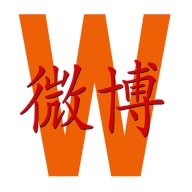Featured
Chinese Relationship Guru to Women: Put Motherhood On Hold
Do not get pregnant too soon – that is the message of China’s most popular relationship advisor to women on Weibo. The post became an instant hit, igniting online discussions on becoming a mom directly after marriage.
Published
10 years agoon
By
Yiying Fan
Do not get pregnant too soon – that is the message of China’s most popular relationship advisor to women on Weibo. The post became an instant hit, igniting online discussions on becoming a mom directly after marriage.
Chinese best-selling author Lu Qi (陆琪), also known as one of the most popular relationship advisors on Sina Weibo, advises Chinese women on his Weibo account not to have children too quickly after getting married. The post resonated with millions of female Weibo users since it was published on May 10.
In the post, titled “Do Not Become a Mother Too Young” (不要太早当妈), Lu Qi writes about how a young girl from rural China had to give up her dream of studying at the China Academy of Art because she got pregnant. She could have become an artist and live the life of her dreams, but instead, she got married young and had a child at 18 years old. She remained in the small rural town with its narrow-minded community, raising the baby instead of going to university. Lu also illustrates how the dreams of a myriad of other young Chinese women were crushed after being forced by their husbands and parents to have kids.
“So many places to explore, so many dreams to pursue.”
Lu Qi shared his thoughts with his 21 million followers on Weibo: “I always believe that it’s irresponsible for a woman to have a child unprepared, no matter whether it’s an accident or persuasion. A mother’s love is a woman’s nature, and some people make use of this ‘nature’ to limit and change women – and they usually get what they want, which is horrible.”
Lu Qi adds that he hopes that all girls will understand that motherhood is not about carrying on the family line, or something that parents or husband urge you to do, and also not something that happens by accident. Having and raising a child will change your life for good. Once you are a mother, you have to be responsible and are limited to do what you can do with your life. There are so many places to explore in the world and so many dreams to pursue – why not achieve these goals when you are still young and then having a child when you and your husband are both ready?
 Relationship guru Lu Qi’s Weibo post ‘do not become a mother too young’ has been viewed over 66 million times.
Relationship guru Lu Qi’s Weibo post ‘do not become a mother too young’ has been viewed over 66 million times.
The hashtag #不要太早当妈# (‘do not become a mother too young’) has been viewed over 66 million times on Weibo in the past few days. An ongoing poll shows that 78% Weibo users support the idea of waiting a while before having babies.
Weibo user ‘Small Fox’ cannot agree more with Lu Qi. She replied on his post: “I would have preferred having babies later in life, but my husband and parents-in-law pushed me very hard to become pregnant as soon as possible. I really regretted my decision as all the efforts I’ve made on my career were in vain. I’m not even sure if I’m able to go back to work after my kid goes to kindergarten, and I don’t know what I can do.”
“I feel like I’m not living for myself.”
“I believe I have the right to say something here, as I’ve already had two kids at age 24,” Weibo user ‘Xiaoshan Niuniu’ writes. She confesses that she would have rather waited a while to have kids if she could choose again: “I feel like I’m not living for myself since I gave birth to my kids. It makes me so sad, especially when my husband leaves the kids alone with me so that he can go out and have fun with his friends. Both husband and wife need to shoulder the responsibility for bringing up the children. However, the society holds the view that the wife is supposed to take care of both the kids and the husband. We also have our own goals and dreams!”
In Chinese culture, women are expected to devote themselves to raising the children and looking after the husband regardless how successful or ambitious they are before tying the knot. In the recent decade, Chinese women increasingly fight for their rights. Female netizens express that it means a lot to them that male icon, Lu Qi, supports them in propagating his message to women: pursue your dreams, working hard for your career, and only become a mother when the time is right.
By Yiying Fan
Follow What’s on Weibo on Twitter
©2015 Whatsonweibo. All rights reserved. Do not reproduce our content without permission – you can contact us at info@whatsonweibo.com.
About the author: Yiying Fan is a world traveler and Chinese freelance writer from Shanghai.
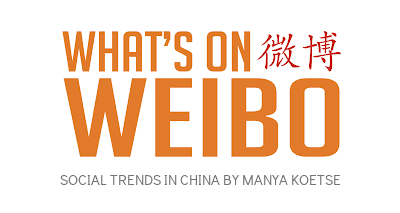
China Insight
China Reacts: 3 Trending Hashtags Shaping the Tariff War Narrative
From historic speeches to trending slogans, this is China’s official media response to the US tariff escalation.
Published
2 days agoon
April 13, 2025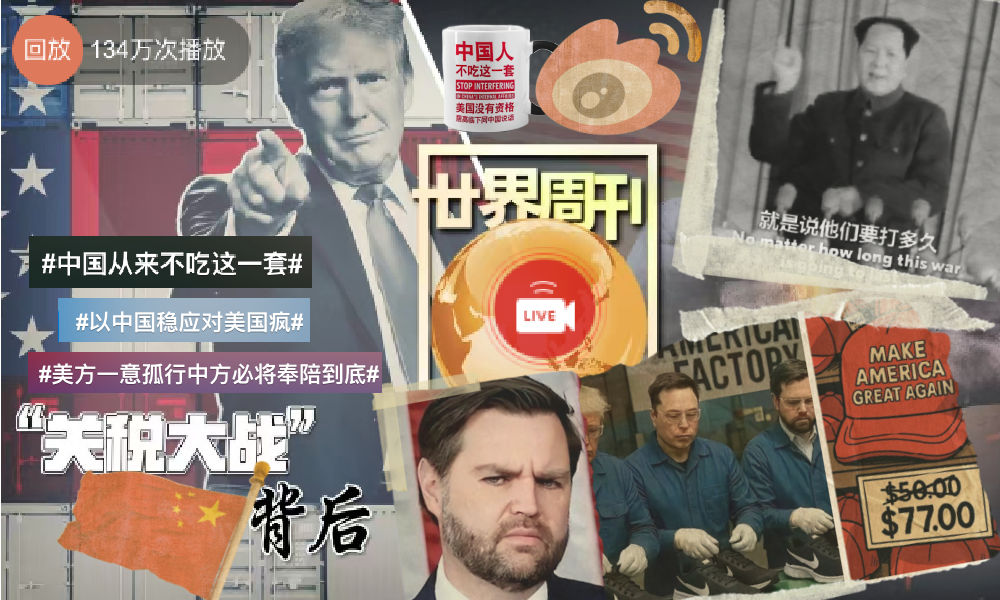
What do Mao’s 1953 Korean War speech and Yang Jiechi’s 2021 Alaska Summit remarks have to do with the escalating US–China trade war? In Chinese official media responses, history and emotionally charged rhetoric are used to clearly signal China’s stance and boost national confidence. Here, we explore three dominant narratives.
As you probably know by now, April 9 marked “D-Day” for Trump’s rollout of steep tariffs. On Chinese social media, the escalating trade war between China and the US dominated conversation, especially on that “D-Day Wednesday,” when nearly all of Weibo’s top 10 most-viewed hashtags were related to Trump’s tariffs and China’s retaliation.
Since developments are unfolding rapidly, here’s a quick recap:
- 🇺🇸💥 On Wednesday, April 2, President Trump announced steep new tariffs, including a universal 10% “minimum base tariff” on all imported goods, and an additional 34% reciprocal tariff specifically targeting China as part of the so-called “Liberation Day,” set to begin on April 9. Combined with pre-existing tariffs, this would bring the total tariff rate on Chinese goods entering the United States to over 54%.
- 🇨🇳⚔️On Friday, April 4, China’s State Council Customs Tariff Commission Office issued an announcement stating that, starting April 10, an additional 34% tariff would be levied on all imported goods originating from the United States, on top of existing tariff rates.
- 🇺🇸⚔️On Tuesday, April 8, Trump vowed to increase tariffs on Chinese exports by an additional 50% if Beijing would not withdraw its 34% counter-tariffs.
- 🇨🇳💥On Wednesday, April 9, China’s finance ministry announced it would further raise tariffs on US goods to 84% starting the following day, in retaliation for the newly imposed 104% tariff on Chinese goods.
- 🇺🇸💣On Wednesday, April 9, Trump then did a U-turn and halted the new steep tariffs for dozens of countries for 90 days, except for China, followed by yet another threat of an additional 21%, bringing those import taxes to 125%.
- 🇺🇸🚨On Thursday, April 10, it was clarified by the White House that tariffs on China would actually total 145%, combining the previously announced 125% with a 20% import tax levied for fentanyl smuggling.
- 🇨🇳💣On Friday, April 11, Chinese official channels reported that China would adjust its tariff measures on important goods from the US starting April 12, raising the rate from 84% to 125%. A related hashtag became no 1 trending topic on Weibo, where it received over 500 million views by Friday night (#对美所有进口商品加征125%关税#).
- 🇺🇸⬅️ On Friday, April 11, Trump’s administration announced that it will exempt smartphones, computers and some other electronic devices from the new tariffs, including the 125% levies imposed on Chinese imports (#特朗普政府再度退缩#; #美国免除智能手机电脑对等关税#).
There are hundreds of hashtags and trending topics circulating across Chinese platforms — from Weibo to Toutiao, from Kuaishou to Douyin — related to the latest developments in the US–China trade war. The topic is super popular, but censored comment sections and removed images also reveal just how sensitive it can be at times.
The biggest hashtags and slogans are those initiated and amplified by official channels. From press conferences to hashtags and visual propaganda, you can see a clear strategic media narrative that draws on history, national pride, and patriotism to frame recent developments, mobilize public sentiment domestically, and show China’s resilience to the rest of the world.
Here, I’ll highlight three hashtags that have recently become top trending, each representing a different kind of official narrative or rhetoric in response to the ongoing developments.
1. China Won’t Back Down
(China will see it through to the end #美方一意孤行中方必将奉陪到底#)
The message that China will not be intimidated by the US is one that echoes across Chinese social media these days, reinforced by official channels.
On April 9, the Weibo account of Chinese media outlet Guancha (@观察者网) and the state-run New Era China Foreign Affairs Think Tank (@新时代中国外交思想库) posted a video showing part of a speech given by Mao Zedong on February 7, 1953, during the final stages of the Korean War at the 4th Session of the 1st National Committee of the Chinese People’s Political Consultative Conference (CPPCC).
In the short fragment, Mao Zedong says:
🇨🇳📢 “As to how long this war will last, we are not the ones who can decide. It used to depend on President Truman, and it will depend on President Eisenhower, or whoever becomes the next US President. It’s up to them. No matter how long this war is going to last, we’ll never yield. We’ll fight until we completely triumph.”
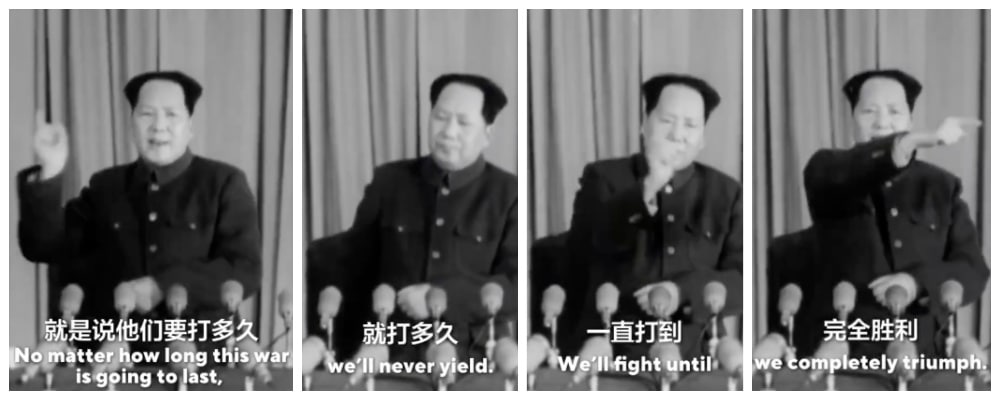
The 1953 speech by Mao was also posted on the US social media platform X by Mao Ning (@毛宁), spokesperson for China’s Ministry of Foreign Affairs. The video was then also spread by blogging accounts and regular netizens. History blogger Zijin Gongzi (@紫禁公子), who has over 435k fans on Weibo, reposted the video, writing:
💬 “Our forefathers never bowed their heads to strong enemies. How could we easily accept defeat? (..) We must not lose this spirit, we must let everyone know that we have a strong backbone and will never bow down.”
Together with the Mao video, the hashtag used by the Think Tank and many other Chinese media accounts, such as People’s Daily (@人民日报), is “If the US obstinately clings to its course, China will fight to the end [lit. accompany them to the end]” (#美方一意孤行中方必将奉陪到底#) and “fight to the end” (#我们奉陪到底#).
These phrases in part come from a press conference given by Ministry of Foreign Affairs spokesperson Lin Jian (林剑) on April 8. Here, he said:
🇨🇳📢 “I want to emphasize once again that there are no winners in trade wars and tariff wars, and protectionism is no way forward. The Chinese people do not provoke trouble, but they are also not afraid. Pressure, threats, and blackmail are not the proper ways to deal with China. China will inevitably take necessary measures and resolutely safeguard its legitimate rights and interests. If the American side disregards the interests of both countries and the international community and insists on waging a tariff war and trade war, China will fight to the end [lit. inevitably accompany them to the end 中方必将奉陪到底].”
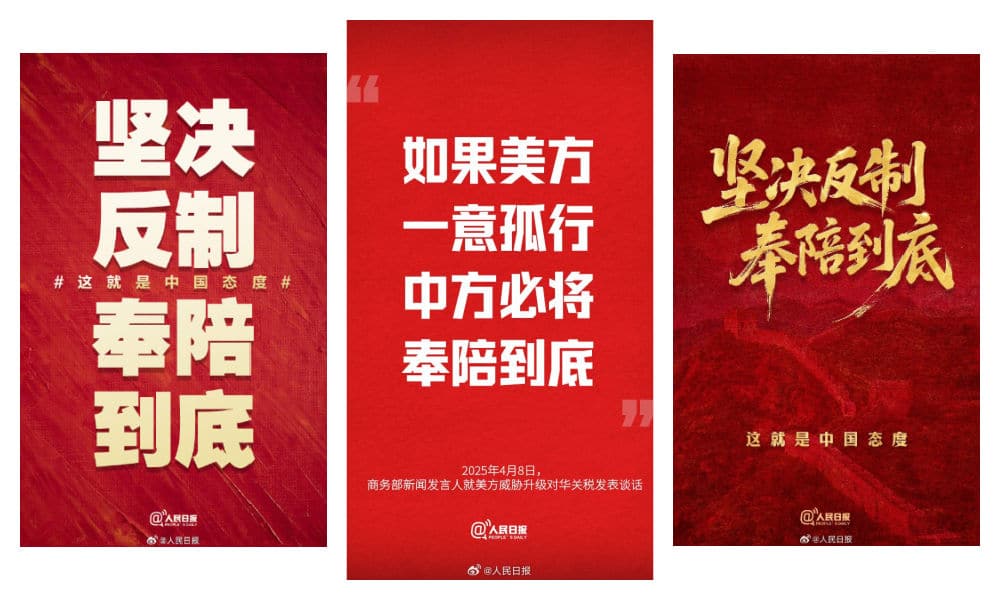
The next day, these words had been turned into digital propaganda posters, with some slight variations in the phrases used. One People’s Daily graphic underlined: “We resolutely take countermeasures, and follow through until the end (坚决反制 奉陪到底),” accompanied by the line: “This is China’s attitude,” which was also turned into a hashtag (#这就是中国态度#).
2. This Is No Way to Deal with China
(Chinese people aren’t buying it #中国人从来不吃这一套#)
Another related yet somewhat different sentiment that dominates Chinese social media—led by official channels—is that China is not only rejecting the trade games played by the US, but is also distancing itself from the American playbook. The message is: this is no way to deal with China. This narrative, and the hashtag surrounding it, emerged slightly later than the first. While the earlier phrase about China not backing down trended as China matched the US in its tariff measures, this one took off with China’s final blow—raising the rate on US imports from 84% to 125% in response to the latest US tariff hikes.
The April 11 statement on the Ministry of Finance website (财政部网站), also posted on Weibo by Xinhua News (@新华社), announced that China would adjust its additional tariff measures on imports originating from the United States effective April 12. It also stated that China strongly condemns the US imposition of excessively high tariffs and will no longer engage in further tariff escalations:
🇨🇳📢 “Given that, at the current tariff level, US goods entering China effectively have no market viability, if the US continues to raise tariffs on Chinese exports to the US, China will no longer respond.”
The main hashtag used by Xinhua and many other media channels is “中国从来不吃这一套” (Zhōngguó cónglái bù chī zhè yī tào), which can be translated as: “The Chinese people have never accepted this,” or more colloquially, “We’re not buying it.”
The phrase initially became popular in 2021, after it was used by China’s top diplomat Yang Jiechi (杨洁篪) during the first major strategic talks of the Biden administration, held in Anchorage on March 19. Due to the occasionally heated exchanges between the two delegations, some called the Alaska talks a “diplomatic clash.”
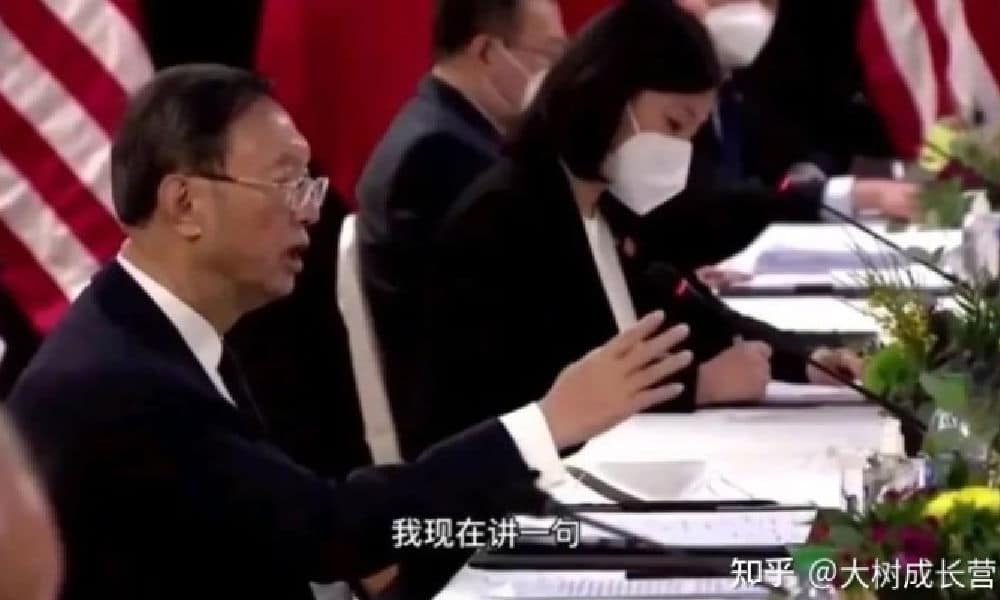
Yang Jiechi during the Alaska Summit
At the time, Yang delivered a lengthy statement to US Secretary of State Antony Blinken and National Security Advisor Jake Sullivan, stressing that Taiwan, Hong Kong, and Xinjiang are “inseparable parts of China,” and that China strongly opposes US interference in its internal affairs. Suggesting the US should focus more on its own human rights issues and racial problems instead of lecturing China, he added the now-famous line: “The US is not qualified to speak to China from a position of strength. The Chinese people don’t buy that” (美国没有资格居高临下同中国说话,中国人不吃这一套).
The phrase quickly went viral—boosted by state media, celebrated by netizens, and turned into a marketing slogan. It now appears on t-shirts, teacups, phone cases, and other patriotic merchandise.
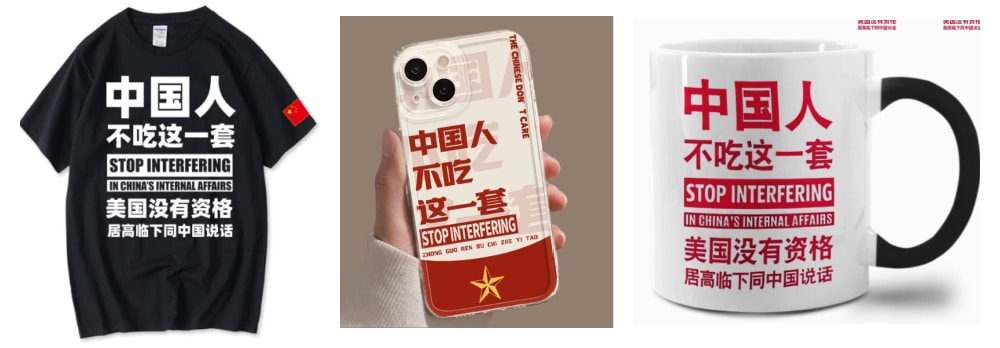
The translation of the phrase still triggers discussions. While merchandise typically translates it as “Stop interfering in China’s internal affairs,” that’s not an accurate translation. During the Alaska Summit, interpreter Zhang Jing (张京) (who gained viral fame at the time) translated it in real-time as “This is not the way to deal with the Chinese people.” However, some commentators and professional translators argued this was a missed opportunity to take a tougher stance, as the Chinese phrase is much sharper and could be loosely translated as: “We Chinese people don’t swallow this crap.”
In Alaska, Yang emphasized that dealing with China requires mutual respect, and that history will prove that trying to strangle China’s rise would ultimately hurt the US itself (“与中国打交道,就要在相互尊重的基础上进行。历史会证明,对中国采取卡脖子的办法,最后受损的是自己。”)
Similar sentiments now dominate online media discourse in China. The slogan has evolved from “The Chinese people don’t buy this” (中国人不吃这一套) to the more authoritative “China has never bought this” (#中国从来不吃这一套#)
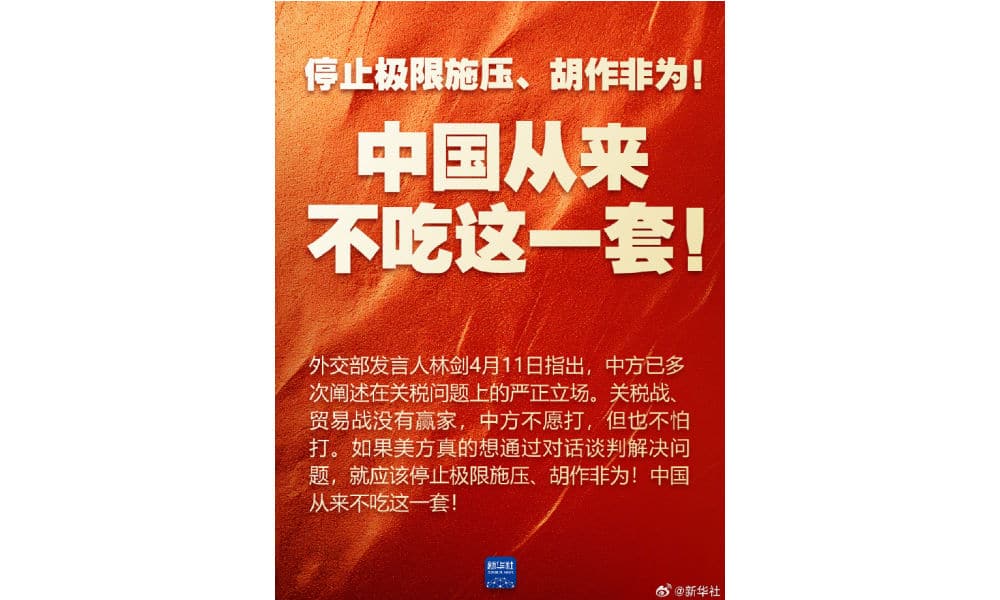
Adding fuel to this message are hashtags like “America’s repeated imposition of excessively high tariffs on China has become a joke” (#美方对华轮番加征畸高关税已沦为笑话#).
Ridiculing America (especially Trump) has become a popular pastime on Chinese social media this past week, with a flood of Chinese and international memes circulating widely.

Especially popular are memes mocking the idea of America as a future “Made-in-America” manufacturing hub, the irony of iconic American products (like MAGA hats) being made in China, and how everyday essentials such as eggs have reached historic price highs in the US (a crisis partly caused by bird flu but now worsened by the tariffs).
On April 13, the hashtag “The 145% tariff makes one panda plush toy cost 80 dollars” (#145%关税让1只熊猫玩偶卖80美元#) also went trending, sparking jokes about how even the most trivial things could suddenly become luxuries in the US.
3. China is the Most Stabile Superpower
(Countering America’s madness with China’s stability #以中国稳应对美国疯#)
A third stance that has been dominant in Chinese official online discourse is that China’s development does not rely on anyone’s favors (#中国发展从不靠谁的恩赐#, derived from a quote by Xi Jinping), and that despite the US’s measures, China’s rise on the world stage cannot be stopped. In fact, the narrative suggests that these actions by the US are only accelerating China’s ascent.
A commentary piece published by state broadcaster CCTV (@央视新闻) on April 11 quoted Professor Li Haidong (李海东) of China Foreign Affairs University, who stated that the US’s increasingly aggressive behavior reinforces the notion that it is using tariffs as a tool of extreme pressure; as a weapon to serve its own interests. According to Li, this reflects America’s hegemonic mindset, aiming to assert superiority by intentionally creating crises.
But rather than strengthening the US, the commentary argues, these recent measures are backfiring and are damaging the US’s domestic economy and undermining its global credibility.
In contrast to the US’s presumed recklessness and “hysterical approach,” China is depicted as a “responsible world leader,” bringing certainty to an uncertain world by “responding with its own stability” and proving to be, supposedly, a more reliable engine of global growth. The commentary states:
🇨🇳📢 “As the tariff storm strikes, China is using its own ‘stability’ to resist the trials and tribulations, by upholding rules, defending justice, and steering the big ship of globalization through treacherous countercurrents, toward the right path of openness and cooperation.”
To promote the piece on social media, CCTV used the hashtag “Responding to America’s madness with China’s stability” (#以中国稳应对美国疯#).
This sentiment was echoed by nationalist bloggers, such as Tangzhe Tongxue (@唐哲同学), who posted on April 13:
💬 “In this world, besides China, the rest are all just a poorly equipped small-town theater troupe (草台班子).”
The phrase “草台班子” (cǎotái bānzi) literally refers to a makeshift opera troupe performing on a shabby rural stage, and is used to describe an incompetent group of amateurs.
The blogger’s comment indirectly responds to comments made by US Vice President JD Vance, who defended Trump’s tariffs in a Fox News interview by saying: “To make it a little more crystal clear, we borrow money from Chinese peasants to buy the things those Chinese peasants manufacture.”
That remark sparked controversy online, with many netizens calling it ignorant. Some pointed out that Chinese people were already wearing fine silks when Westerners were still wrapped in animal skins fishing in the sea, and flipping the narrative to portray Americans as the real “country bumpkins.”

Meme shared online.
This sentiment was reinforced by another hashtag trending on Weibo on April 13: “You think we’re scared, but we actually don’t care” (#你以为我们scared其实我们不care#).
That line comes from a Channel 4 interview with Gao Zhikai (Victor Gao/高志凯), Vice President of the Center for China & Globalization (CCG), who stated:
🇨🇳📢 “China is fully prepared to fight to the very end. Because the world is big enough that the United States is not the totality of the market in the world. So if the United States wants to go in that direction of completely shutting itself out of the Chinese market, be my guest. [Interviewer: Yes and China will lose the US market..] We don’t care. We don’t care. China has been here for 5000 years, and for most of the time there was no United States and we survived. If the United States wants to bully China, we will deal with the situation without the United States. And we except to survive for another 5000 years.”
While this reflects the official position and is widely echoed across social media, others stress the importance of remembering history; particularly China’s “Century of Humiliation” (百年国耻), which was marked by war, aggression, and unequal treaties imposed by foreign powers. Just like other historical anniversaries, some bloggers argue that Trump’s tariff “D-Day,” April 9, should not be forgotten (“今天是每个中国人难以释怀的日子”) and that it marks another reason for China’s renewed rise.
In a video posted by CCTV’s short video platform Xiaoyang Shipin (小央视频) on April 13 (link), the narrator states:
🇨🇳📢 “The so-called global “beacon” now puts “America first.” It slaps allies in the face, treats the world with predatory practices, and makes other countries pay for MAGA, pushing the fragile word economy over the edge, and pitching itself against the whole world. With China here, the sky won’t fall. With around 5% economic growth, China adds the output of a mid-sized European economy every year. China has hundreds of millions of skilled workers. The Chinese people are well known for their strong work ethic. China’s development over the past seven decades is a result of self-reliance and hard work, not favors from others, (..) Global businesses believe the next China is still China and the best is yet to come (..) Markets need to restore faith. Between the pond of closed markets, and the ocean of economic interconnectivity, which one would you choose?”
Overall, packaged across different media — from hashtags to short videos, from press conferences to news reports, and from digital slogan posters to Ministry of Foreign Affairs tweets — China’s strategic political media messaging is clear and quite powerful, despite the fragile and censored environment it operates in: China is not afraid to strike back, China will lead with calm, and eventually, China will emerge as the winner. Whatever happens next remains to be seen, but when it comes to turning crisis into opportunity, China’s official media channels have already done just that.
By Manya Koetse
(follow on X, LinkedIn, or Instagram)
Spotted a mistake or want to add something? Please let us know in comments below or email us. First-time commenters, please be patient – we will have to manually approve your comment before it appears.
©2025 Whatsonweibo. All rights reserved. Do not reproduce our content without permission – you can contact us at info@whatsonweibo.com.
Dear Reader
No Quiet Qingming: From High-Tech Tomb-Sweeping to IShowSpeed & the Seven China Streams
It’s been a week where rituals met robots, IShowSpeed’s China streams got an upgrade, and quiet was nowhere to be found.
Published
1 week agoon
April 6, 2025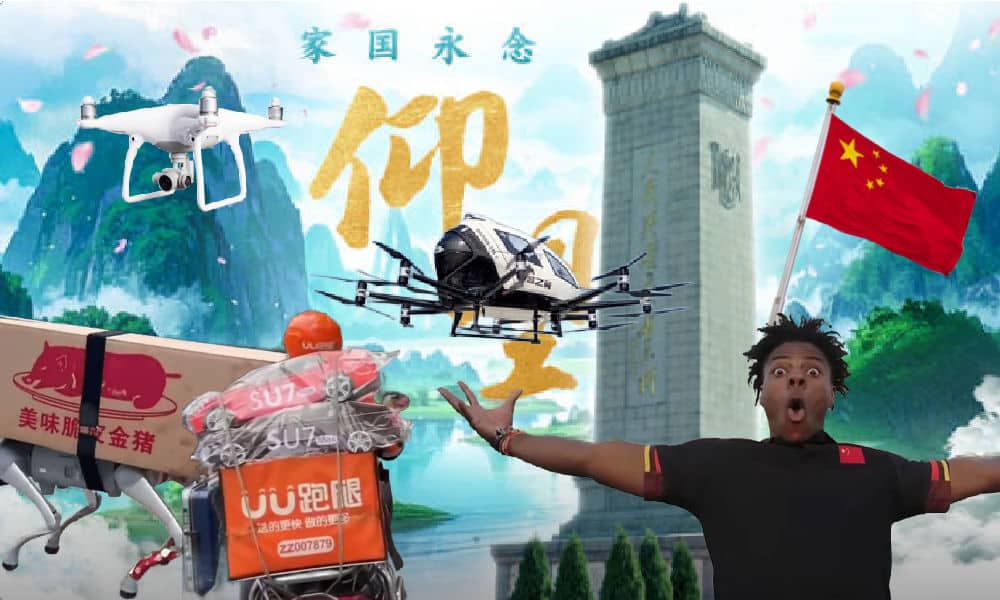
FROM THE WEIBO WATCH PREMIUM NEWSLETTER
Dear Reader,
It’s been a tumultuous news week, with discussions and trending topics on Chinese social media going from international events like the Myanmar earthquake or the impeachment of South Korean (former) President Yoon Suk Yeol to major discussions on the safety and abuse of the autopilot feature on electric vehicles, the US trade war, and new military exercises around Taiwan.
🧹 With so much going on, this year’s Qingming Festival (清明节) felt especially welcome. Also known as Tomb-Sweeping Day, Qingming fell on April 4 this year. It is a special time to reflect, pause, and honor family ancestors by visiting graves, making offerings, and burning spirit money.
🧳 It’s also a public holiday and a popular time for travel. And so, instead of a quiet time, many popular tourist spots across China turned into a sea of people. One example is Qingdao, where the famous Zhanqiao Pier (栈桥) — the one featured on the Tsingtao Beer label — became more people than pier. That crowded hotspot scene sparked the trending hashtag “#人人人人栈桥人人人人#”: People-People-People-People-Zhanqiao-People-People-People-People.
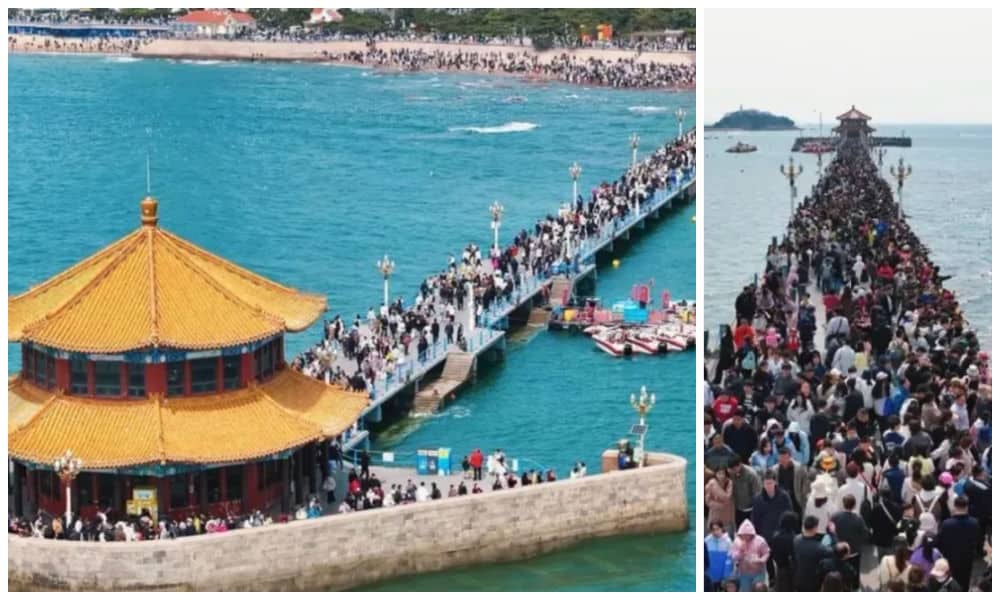
More people than pier in Qingdao, images via Qingdao Daily 青岛日报
On Chinese social media, it has become somewhat of a tradition to post about just how busy it is at China’s various sightseeing spots. This is often done using the hashtags “人人人人[place]人人人人” or “人人人人[me]人人人人.” The character 人 (rén) means person or human; “人人” (rénrén) means “everyone,” and the more “人人人” (rén rén rén) are used, the more it playfully emphasizes the crowds of people.
Since it was also very crowded this weekend at Hangzhou West Lake, Mount Qingcheng, the Longmen Grottoes, the Hubei Provincial Museum (people lining up to see the Sword of Gouijan), and many other places, there were similar hashtags for various places going around Weibo.
📰 Qingming Festival is also a busy time for state media, as the holiday ties into broader narratives about the nation and remembering those who defended the homeland.
State media-initiated hashtags like “Forever Remember [for] the Homeland, Salute to Our Heroes” (#家国永念致敬英雄#) are used in posts about key commemorations — such as the China Coast Guard observing a moment of silence facing the sea and scattering flowers in honor of China’s martyrs.

CCTV poster 家国永念, Always Remember [for] the Homeland.
One especially notable grave visit covered by the media this weekend was that of Mao Xinyu (毛新宇), the only surviving grandson of Mao Zedong. He returned to Mao’s birthplace, Shaoshan, with his family to pay tribute to his grandfather. At the statue of Mao, great-granddaughter Mao Tianyi (毛甜懿) also spoke a few words, wishing her great-grandfather peace and expressing hope that she could live up to his expectations (see video).
💸 For China’s paper offering businesses, the period around Qingming Festival is anything but quiet. Over the past years—and especially in the age of booming e-commerce—the ancient ritual of paper offerings has undergone major transformations and become increasingly extravagant. By burning ritual paper gifts, it’s believed that these offerings are sent to the afterlife.
To please the ancestors—and perhaps sometimes to impress the neighbors, too—people now burn all kinds of things, from paper liquor to cardboard Rolex watches. Some take it a step further, creating entire paper replicas of two-story villas or palaces to honor their ancestors. Chinese media reported that one vendor in Jiangsu’s Nantong was selling a 200 m² paper villa, complete with rooms, for 15,000 yuan ($2,060)—it even had a car in the driveway (video)! Another video showed neighbors gathering to watch such a paper mansion go up in flames.

This year, one item that particularly caught attention on WeChat and Xiaohongshu was a paper version of the Xiaomi SU7 EV. A video showing these offerings strapped to the back of a delivery scooter went viral—apparently, Xiaomi is more popular than BMW this year (read last year’s article about Burning BMWs here).
🪦 At least for the people visiting their family’s graves and bringing offerings, Qingming should be a relaxing time, right? Not exactly — or at least, not for everyone. This year, the Qingming Festival ancestral worship activities of the “South China F3” (华南F3, referring to Guangdong, Guangxi, and Hainan) have sparked widespread discussion for just how dramatic and hardcore they can get.
Many people in these southern provinces, especially in rural and mountainous areas, have become known for going all out when it comes to ancestral worship during Qingming. Climbing mountains, entering caves, wading through rivers — some ancestral graves are so hidden that tomb-sweeping day feels more like a wilderness survival challenge for the families trying to reach them.

Tomb-sweeping days can feel more like a wilderness training for some in more remote and mountainous areas.
On Friday, Toutiao News reported that new technologies are now helping people pay respects when graves are located in remote, hard-to-access areas. Since 2021, one entrepreneur from Guangxi has been using drones to deliver offerings into the mountains. GPS apps help track routes to ancestral tombs, and robotic dogs are even being used to carry food and offerings up steep paths.
So while technology is making ancestral rites more efficient, it’s also adding new layers of intensity to rituals that perhaps were never meant to be fast-paced in the first place.
📱🐼 IShowSpeed and the Seven China Streams
Robots, drones, flying cars — they are not just becoming part of China’s old traditions, they’re also a major part of China’s new narratives, and this was particularly clear this week in the many hours of livestreaming by the famous American YouTuber IShowSpeed (Darren Jason Watkins Jr.).
After Shanghai, Beijing, and the Shaolin Temple in Henan, IShowSpeed continued to livestream from Chengdu, Chongqing, Hong Kong, and Shenzhen. His seven China streams together make up over 43 hours of footage, and I’ll admit that I’ve seen the great majority of it.
Last week, I already did a deep dive into the significance of IShowSpeed’s China tour, and how his streams have been used by Chinese official channels and state media as part of the strategy to tell China’s story well, and also to spread China’s message effectively — preferably through genuine and engaging stories. (In case you missed it, read the analysis here).
This week’s streams showed that both IShowSpeed’s team and the Chinese coordinators behind the scenes were even better prepared for the livestreamed visits and the enormous spectacle it brings to the places he goes. Some Chinese state media even started livestreaming his streams as well. In just ten days, Watkins has become a mega-celebrity in China, where he wasn’t that famous before — and he’s been trending on social media practically every day since March 24. Outside of China, his influence is also growing. During his Hong Kong stream, he reached a personal record of 38 million YouTube subscribers.
IShowSpeed is no longer just an American personality — he’s a marketing platform. Chinese authorities, state media, companies, brands, e-commerce channels, and influencers are all jumping in on the hype to benefit from his popularity.
From the top-down narrative perspective, his China tour has been a huge success. Kung fu performances, traditional opera, pandas, Chinese dance and music, local cuisine highlights, the Great Wall, traditional medicine and yin-yang, futuristic cities alongside ancient culture, high-speed rail, noodles, dancing aunties, and Shaolin monks — his streams became an ultimate representation of the Chinese cultural promotion playbook, and were reported on as such. China’s national broadcaster CCTV aired an entire 8-minute segment on his China tour, covering his adventures.
When Watkins’ livestreams started to include aerial drone footage with spectacular views — and especially when dancing with robots was added to the list of activities — I couldn’t help but see a resemblance between his 5+ hour stream and the famous Spring Festival Gala: a tightly programmed spectacle featuring Chinese opera, kung fu, and traditional cultural highlights mixed with cutting-edge technology.
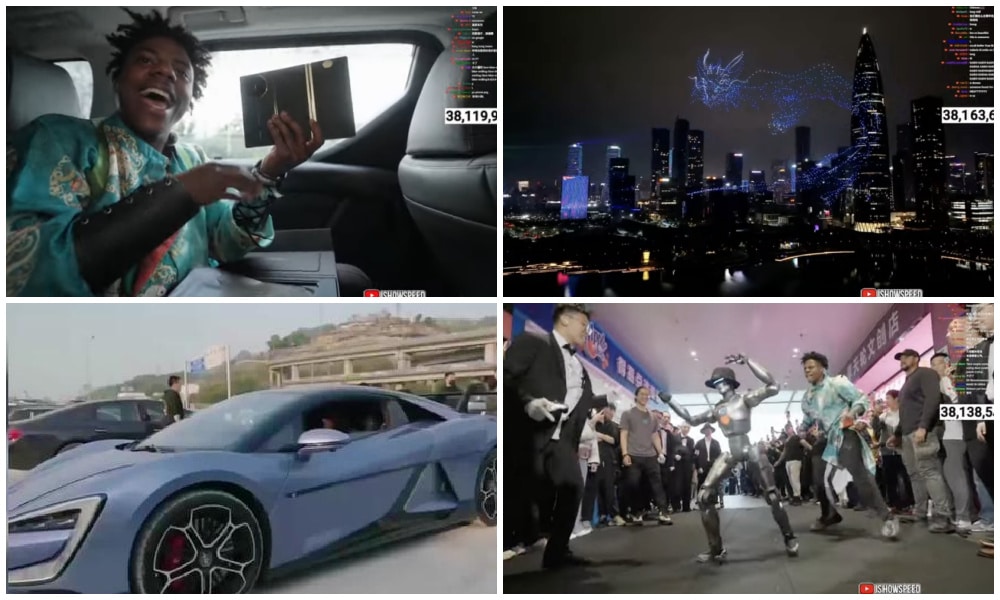
Watkins’ latest visit to Shenzhen especially became a celebration of Chinese tech. Not only did he do the robot dance and purchase three Huawei Mate X3 tri-fold phones (he also got futuristic BYD Yangwang U9 in Chongqing), the city had also organized a spectacular dragon drone show. Watkins also took a ride in a “flying car” — the EH216-S by tech company EHang (亿航). Just last week, EHang received official approval to operate the aircraft in China. While these flying vehicles will mainly be used for tourism and sightseeing at first, they’re expected to be part of low-altitude urban commuting in the future. Starting later this year, you’ll be able to try it out yourself in Hefei, where public tourism flights will begin.

No wonder the EHang team was thrilled with the exposure. Besides a cultural ambassador to China, IShowSpeed’s been the best brand ambassador they could’ve hoped for.
At the same time, Watkins is anything but quiet, and his chaotic streams haven’t exactly brought moments of reflection during this year’s Qingming Festival. Today is a free day for him, offering some peace and quiet — for him, his team, and the entire circus surrounding the tour.
Wishing you a calm Sunday! Check out the rest of the newsletter here (link coming soon).
Special thanks to Miranda Barnes for contributing to this week’s issue. As always, thank you for your support — and don’t hesitate to reach out with any questions or suggestions.
Best,
Manya
(follow on X, LinkedIn, or Instagram)
Spotted a mistake or want to add something? Please let us know in comments below or email us. First-time commenters, please be patient – we will have to manually approve your comment before it appears.
©2025 Whatsonweibo. All rights reserved. Do not reproduce our content without permission – you can contact us at info@whatsonweibo.com.
Subscribe

China Reacts: 3 Trending Hashtags Shaping the Tariff War Narrative

No Quiet Qingming: From High-Tech Tomb-Sweeping to IShowSpeed & the Seven China Streams

From Trade Crisis to Patriotic Push: Chinese Online Reactions to Trump’s Tariffs

China Trending Week 14: Gucci Fake Lipstick, Xiaomi SU7 Crash, Yoon’s Impeachment

Strange Encounter During IShowSpeed’s Chengdu Livestream

“Dear Li Hua”: The TikTok/Xiaohongshu Honeymoon Explained

Beyond the Box Office: What’s Behind Ne Zha 2’s Success?

Weibo Watch: A New Chapter

15 Years of Weibo: The Evolution of China’s Social Media Giant

Tuning Into the Year of the Snake

IShowSpeed in China: Streaming China’s Stories Well

TikTok Refugees, Xiaohongshu, and the Letters from Li Hua

The ‘China-chic Girl’ Image and the Realities of China’s Competitive Food Delivery Market

US-Russia Rapprochement and “Saint Zelensky”: Chinese Online Reactions to Trump’s Shake-Up

“Black Myth: Wukong”: From Gaming Screens to the CMG Spring Festival Gala?
Get in touch
Would you like to become a contributor, or do you have any tips or suggestions? Get in touch here!
Popular Reads
-
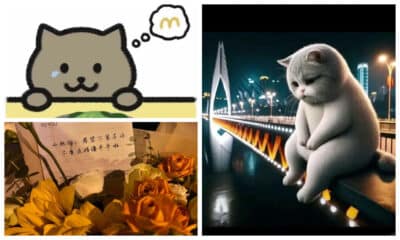
 China Insight11 months ago
China Insight11 months agoThe Tragic Story of “Fat Cat”: How a Chinese Gamer’s Suicide Went Viral
-

 China Digital10 months ago
China Digital10 months agoChina’s 2024 Gaokao Triggers Online Discussions on AI
-

 China Arts & Entertainment11 months ago
China Arts & Entertainment11 months agoSinging Competition or Patriotic Fight? Hunan TV’s ‘Singer 2024’ Stirs Nationalistic Sentiments
-
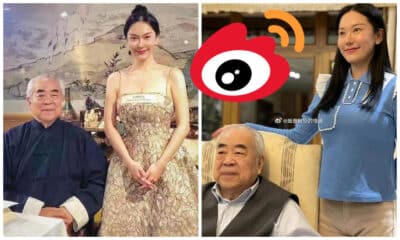
 China Arts & Entertainment12 months ago
China Arts & Entertainment12 months ago“Old Bull Eating Young Grass”: 86-Year-Old Chinese Painter Fan Zeng Marries 36-Year-Old Xu Meng
